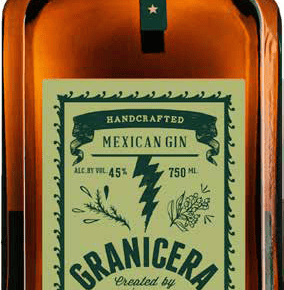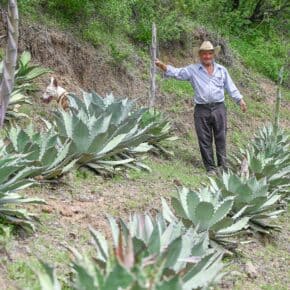I’ll never forget that first sip of Ancho Reyes, the chile liquor from Montelobos. It was of course at a mezcal tasting held, appropriately enough, for the screening of Viva Mezcal at Guelaguetza Restaurant in Los Angeles. Ivan Saldaña, the mad botanist/chemist behind Montelobos Mezcal, pulled a bottle out for some of us to try. This was the spring of 2012: What we now know as Ancho Reyes was months away from launching in the market. At that moment we hadn’t a clue what this was or how it would eventually take the cocktail market by storm. We tried it several different ways – neat, over ice, with club soda. Across the board, the reaction was, well, highly enthusiastic to say the least. The flavor was so deep and spicy–it was the perfect essence of smoked chile in a bottle.
With that kind of a track record, you can imagine the buzz about the soon-to-be-launched Ancho Verde. I was lucky enough to get an early try, and to catch up with Ivan to talk about this new addition to his portfolio.
Saldaña has a long history in the agave world. As a scientist he has a deep background of studying agaves and how we process flavors, and in 2011, he launched Montelobos Mezcal. He is also a big proponent of pushing for sustainability in the agave world, especially to make sure that brands take responsibility. Montelobos was his baby and quite a strong exemplar of all his ideas, so much so that the foray into Ancho Reyes was a side project. Then the cocktail world got ahold of it.
Enter the ancho
To back up a step, the ancho chile is a dried poblano chile. The difference between fresh and dried chile is profound and a huge component of Mexican cuisine. While the fresh poblano is the basis for the famous Chiles en Nogada, that rich and fruity stuffed chile dish made famous in Puebla, the dried ancho chile is used as a basis for dried chile mixes, pozole, and hot sauces because it creates such a mild and smoky spiciness. Pit bosses love it for rubs–you probably have it in your pantry right now mixed in with a BBQ or smoky spice mix.
This chile duality is frequently foreign to many North Americans but it’s everywhere you look. That chipotle chile in your sauce? It’s just a smoked jalapeño. Yes, one of those spicy jalapeños that you swore you’d never try again but have probably eaten in any number of sauces whether they’re served at the Chipotle chain or your very own fridge. On a similar note, the famous morita chile is a dried serrano. Get the idea? Same peppers, completely different flavor when they’re dried. The challenge for Ivan and his collaborators was clear, having perfectly captured that complex smokey flavor of the ancho, why not take on the challenge of making an Ancho Reyes liquor from the poblano?
From red to green
As it turned out, it was a tremendous challenge, and a bit of an existential crisis for a company that was supposed to be focused on mezcal. Saldaña told me, “We held off on releasing the verde because we really needed to think about why we were doing this product and who our company was. What we eventually came to was that we want to bring the authentic flavors of Mexico in different bottles.” Given the complexity of flavors in Mexico, the company has certainly hit upon an endless well of possibilities.
Putting the field in the bottle
As most chefs know, fresh chiles can be tough to work with, partially because the heat can be so inconsistent. Generally speaking, poblanos fall on the milder end of the heat scale and are pretty herbaceous in their flavor. As they ripen, the poblanos develop more sugars, which is why their flavor deepens after they’re dried.
Saldaña has spent so much time in fields working through the nuances of how to capture agricultural flavor in a bottle that he has a keen sense for how to filter raw materials through Mexican tradition into a final product. He’s found that working with farmers is critical to the venture as Montelobos creates a food culture up and down the chain for production.
“As a company we have created this great platform with an exploratory eye on how to bring these different flavors of Mexico into the market. Key to this is developing relationships with the farmers so we can capture the best flavors.” These bookend chile liquors are the perfect spirit expressions of that direct link to agriculture.
The backbone of the liquors are a sugar cane spirit (aguariente) from Veracruz. To get the flavor balance right, some of the peppers used in the Ancho Reyes Verde are roasted and then macerated with fresh peppers. The end product is still pretty green and piquant in flavor – it presents a fresh contrast to the roasted smoke of the Classic Ancho Reyes. While the Ancho Reyes became my Fernet replacement for an end of the night digestivo, I can see Verde becoming my new favorite aperitif and it certainly has great potential as an ingredient in mezcal cocktails. It’s possible, just barely, that Saldaña has succeeded more with Ancho Reyes Verde in capturing an authentic flavor of Mexico. Over ice, each sip takes me back to this shack on a beach on the coast of Oaxaca where I had the freshest and best green salsa, ever.













Leave a Comment